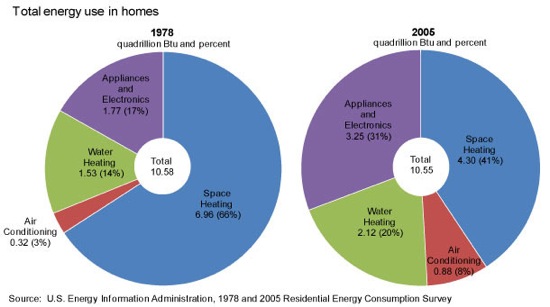The Energy Information Administration's Residential Energy Consumption Survey, released yesterday, shows that average household energy usage has remained remarkably stable over the last 30 years — even as appliances have gotten way more efficient.
Why? Well, we just have a pantload more appliances. (Seriously, look in your pants RIGHT NOW. Do you have a gadget in them? Chances are you do. I've got a phone in my pocket as I write this.) Also, there are 34.5 million more households in the U.S. than there were in 1978, and we're leading increasingly white-collar lifestyles — air conditioners, dishwashers, washing machines. If our dishwashers are 25 percent more efficient, but we have 25 percent more of them, that about cancels out.
A few stats from the EIA survey:
- Percent of households with air conditioning in 1978: 23. In 2009: 61.
- Percent of households with dishwashers in 1978: 35. In 2009: 59.
- Percent of households with washing machines in 1978: 74. In 2009: 82.
- Percent of households with personal computers in 1978: Practically none. In 2009: 76.
- Percent of households with a television screen larger than 37 inches in 1978: Are you kidding? In 2009: 45.
- Also, 79 percent of homes in 2009 had a DVD player, 43 percent had a DVR, and nearly a third had at least four electronic devices plugged in at any given time.
It's not necessarily true that having more efficient (and therefore cheaper) energy CAUSES us to use more. It may be that advances in science and electronics cause both more efficient gadgets, and more of them. But it definitely seems to be the case that, compared to changing our hyper-consuming culture, making strides in the efficiency of individual appliances doesn't make much of a difference.
[UPDATE from the editor: Grist contributor Frank Ackerman argues that this post gets it wrong. Read his rebuttal: "Think energy efficiency isn't working? Think again"]



